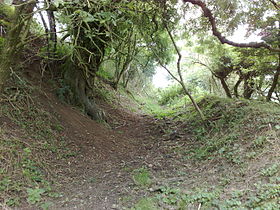Battle of Deorham
| Battle of Deorham | |||||||
|---|---|---|---|---|---|---|---|
| Part of the Anglo-Saxon settlement of Britain | |||||||
 Earthworks around Hinton Hill just north of Dyrham Earthworks around Hinton Hill just north of Dyrham |
|||||||
|
|||||||
| Belligerents | |||||||
| West Saxons | Britons of Bath, Gloucester and Cirencester | ||||||
| Commanders and leaders | |||||||
|
Ceawlin, Cuthwine |
Conmail, Condidan, Farinmail |
||||||
The Battle of Deorham (or Dyrham) was a decisive military encounter between the West Saxons and the Britons of the West Country in 577. The battle, which was a major victory for the Wessex forces led by Ceawlin and his son, Cuthwine, resulted in the capture of the Brythonic cities of Glevum (Gloucester), Corinium Dobunnorum (Cirencester) and Aquae Sulis (Bath). It also led to the permanent cultural and ethnic separation of Dumnonia (Devon and Cornwall) from Wales.
The Anglo-Saxon Chronicle is the only source that carries a mention of the battle. Although it gives few details, it describes it as a major engagement. The location of the Deorham is Hinton Hill near to Dyrham in South Gloucestershire.
The Anglo-Saxon Chronicle entry for 577 records that that year King Ceawlin of Wessex and his young son Cuthwine fought the Britons of the West Country at "the spot that is called [Deorham]". This is generally taken to be Dyrham in what is now South Gloucestershire, on the Cotswolds escarpment a few miles north of Bath. The West Saxons carried the day, and three kings of the Britons, whose names are given as Conmail, and Condidan, and Farinmail, were slain. As a result of the battle, the West Saxons took three important cities, Glevum, Corinium Dobunnorum and Aquae Sulis, representing Gloucestershire and Worcestershire east of the Severn, and a small part of northeastern Somerset.
...
Wikipedia
